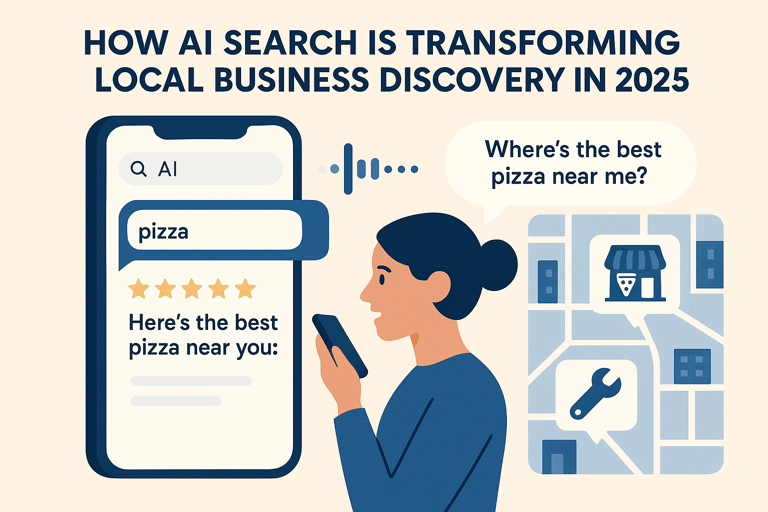The New Reality of Local AI Search: From Blue Links to Real Answers
Remember when finding a local business meant typing keywords into Google and scrolling through pages of blue links? Those days are rapidly fading into memory. In 2025, AI-powered search has fundamentally changed how customers discover local businesses, from restaurants and retail shops to service providers and professional practices.
Today’s consumers are increasingly asking their AI assistants questions like “Where’s the best pizza near me?” or “Find a plumber who can come tomorrow morning” rather than typing keywords into a search box. This shift represents both a challenge and an opportunity for local businesses that understand how to optimize for AI discovery.
The Data Behind the Local AI Search Revolution
The numbers tell a compelling story about this transformation. According to recent research, 71.5% of Americans now use AI tools for search, with usage particularly high among younger generations. Voice search continues its explosive growth, with over 60% of smartphone users regularly using voice to find local services.
Even more striking is the impact on consumer behavior: 82% of voice-activated search users look for local business information, and 76% of smart speaker owners conduct local searches at least weekly. For local businesses, visibility in AI search results has become a make-or-break proposition.
How AI Search Differs From Traditional Local SEO
Traditional local SEO focused primarily on Google Business Profile optimization, local keywords, and building citations across business directories. While these elements remain important, AI search introduces new priorities:
1. Conversational Query Understanding
AI search analyzes natural language queries to extract intent and context. Instead of matching keywords, AI systems try to understand what a person is truly asking and provide the most helpful answer.
For example, when someone asks, “Where can I get a great haircut for curly hair that’s open this evening?”, an AI search engine processes multiple parameters:
- Service type (haircut)
- Specialization (curly hair)
- Quality indicator (great)
- Availability (open this evening)
2. Entity Recognition and Knowledge Graphs
Modern AI systems maintain extensive knowledge graphs that connect entities (businesses, people, places) and understand their relationships. When your business is properly represented as an entity with clear attributes and connections, AI can better match it to relevant queries.
3. Contextual Awareness
AI search considers the user’s location, time of day, search history, and even weather conditions when delivering local business recommendations. This contextual awareness creates opportunities for hyper-relevant matching that wasn’t possible with traditional search.
4. Direct Answers vs. Website Visits
Perhaps most significantly, AI often delivers answers directly to users without requiring a website visit. Your business information might be presented as the solution to a query without the user ever seeing your website, making accurate, comprehensive business data crucial.
Real-World Success: Local Businesses Thriving with AI Search
The Case of Riverfront Moving Company
Riverfront Moving, a small local moving service in Toronto, implemented a comprehensive AI search optimization strategy in late 2024. The results were remarkable: a 78% increase in direct inquiries and a 42% boost in booked jobs within just three months.
Their approach included:
- Implementing structured data markup for services, service areas, and availability
- Creating conversational Q&A content addressing common moving questions
- Ensuring voice search registration across all major platforms
- Developing specific content for neighborhood-level queries
“Before optimizing for AI search, we were invisible to voice assistants,” says Marcus Chen, owner of Riverfront Moving. “Now, when someone asks for moving services in our area, we’re consistently recommended as a top option.”
Main Street Bakery’s Voice Search Success
Similarly, Main Street Bakery implemented AI search optimization focusing on voice queries related to specialty diets and celebration cakes. By structuring their content to directly answer questions like “Who makes gluten-free birthday cakes near me?”, they saw a 63% increase in specialty cake orders.
Their strategy included:
- Optimizing for long-tail, question-format keywords
- Creating structured FAQ content addressing dietary restrictions
- Implementing schema markup for bakery items and specialties
- Building a comprehensive Google Business Profile with detailed service offerings
Practical Steps for Local Businesses to Optimize for AI Search
1. Optimize Your Google Business Profile
Your Google Business Profile remains the foundation of local search visibility. Ensure it includes:
- Accurate NAP (Name, Address, Phone) information
- Comprehensive service listings
- Regular updates and posts
- Responses to all customer reviews
- High-quality photos
Beyond the basics, use the business description to incorporate natural language that matches how customers would ask about your business.
2. Implement Structured Data Markup
Structured data (schema markup) helps AI systems understand your business information with certainty. Key schemas for local businesses include:
- LocalBusiness schema (and relevant subtypes)
- Service schema for specific offerings
- OpeningHoursSpecification schema
- Review schema
Our free AISO Analyzer tool can help identify missing schema opportunities on your website.
3. Create Conversational Content That Answers Questions
Develop content that answers customers’ questions about your products, services, or location. Format this content as natural questions with concise answers.
For example:
- “Do you offer same-day service?”
- “What areas do you deliver to?”
- “How much does a basic haircut cost?”
- “Do you have gluten-free options?”
This Q&A format is particularly effective for voice search results, where AI assistants often read answers verbatim.
4. Optimize for Local Voice Search
Voice searches are longer, more conversational, and often include question words (who, what, where, when, why, how). Optimizing for voice search means:
- Registering with voice search platforms
- Creating content that matches natural speech patterns
- Using schema markup that supports voice search
- Including location-specific terms in your content
A BrightLocal study found that 58% of consumers used voice search to find local business information in the past year, making voice search an essential channel for local discovery.
5. Build Entity Associations
Help AI understand what your business is known for by building strong entity associations:
- Get mentioned in relevant local publications
- Earn reviews that mention your specialties
- Create content that establishes expertise in your field
- Connect with related businesses and organizations
When AI systems recognize your business as an entity associated with specific services or qualities, they will likely recommend you for relevant queries.
Common AI Search Optimization Pitfalls for Local Businesses
While implementing your AI search strategy, avoid these common mistakes:
- Inconsistent NAP Information: Ensure your name, address, and phone number are identical across all platforms.
- Ignoring Review Management: Reviews signal quality and relevance to AI systems; monitoring and responding to them is essential.
- Neglecting Mobile Experience: Many voice searches occur on mobile devices, making mobile optimization crucial.
- Keyword Stuffing: Natural language optimization is about conversational content, not cramming keywords.
- Using Technical Jargon: AI prioritizes clear, accessible content over industry terminology.
Future-Proofing Your Local Business for AI Search
The AI search landscape continues to evolve rapidly. To stay ahead:
- Monitor AI Search Updates: Follow platform announcements from Google, Microsoft, Apple, and Amazon about changes to their AI capabilities.
- Analyze Voice Query Data: Use tools that show what voice queries bring users to your business.
- Test AI Responses: Regularly ask various AI assistants questions related to your business to see if you appear in results.
- Consider AI Chatbots: Implement your own conversational AI to provide immediate answers to customer questions.
Start Your AI Search Optimization Journey Today
As AI continues reshaping how customers discover local businesses, the window of opportunity to gain a competitive advantage is closing. Early adopters are already seeing significant benefits, while those who delay risk becoming invisible in AI-driven search results.
Ready to ensure your business thrives in the AI search landscape? Get your free AI Search Readiness Score or explore our guide to AI Search Optimization for local businesses.
Remember: In 2025, it’s not just about ranking #1 in traditional search results—it’s about being the business that AI recommends when customers ask for what you offer.
This blog is part of our ongoing series on AI Search Optimization. For industry-specific AISO strategies, you can check out our specialized guides for restaurants, professional services, and retail businesses.



